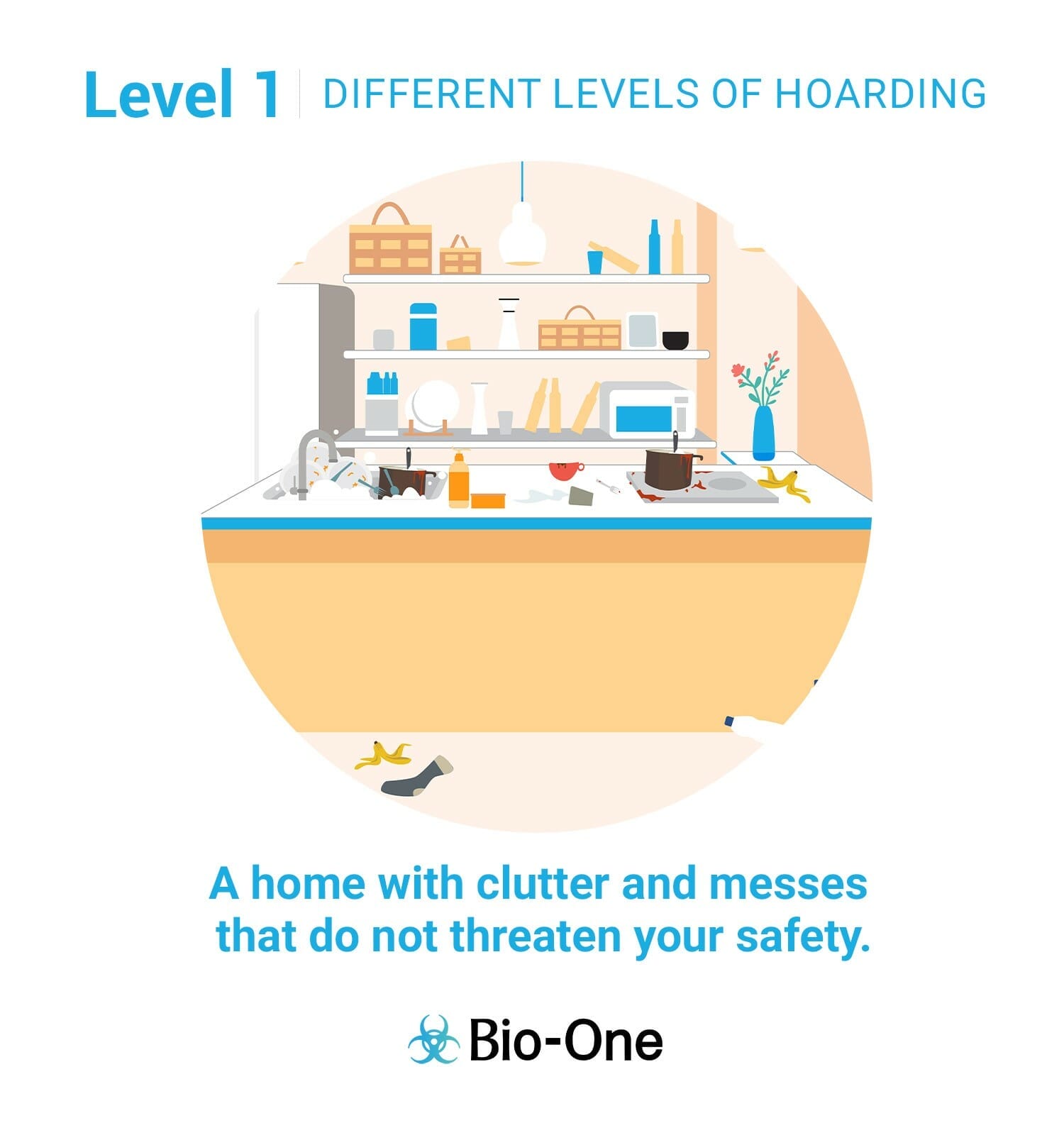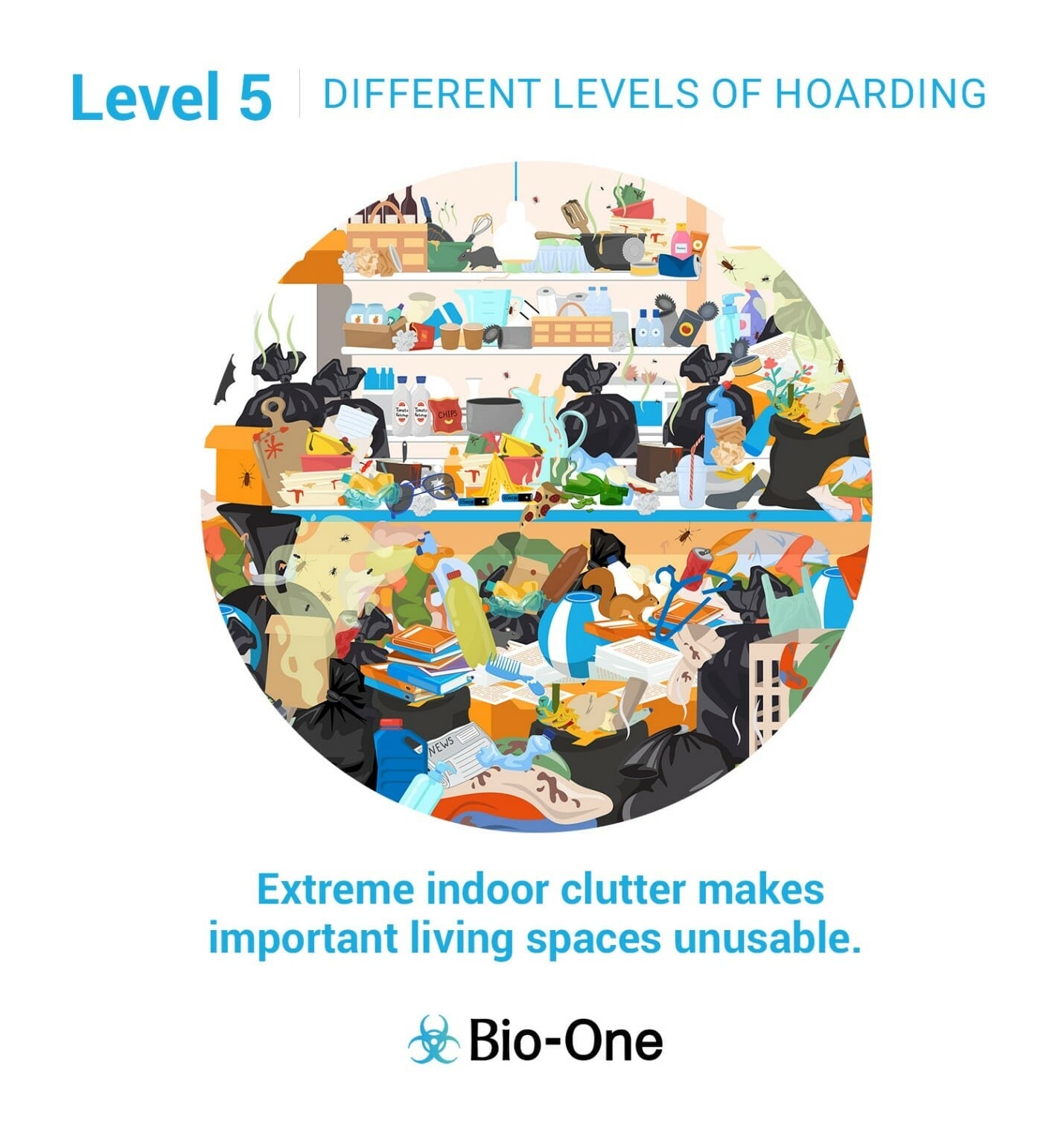
The word “hoarding” probably evokes a particular image, made more common by shows like Hoarders that highlight extreme examples. In reality, not all hoarders have rooms full of items piled high to the ceiling.
The Institute for Challenging Disorganization (now, there’s a relatable title!) has classified hoarding behavior into five levels on their Clutter-Hoarding Scale.Level 1 Hoarding

At Level 1, a home is not pristine, but the space is still easily accessible and sanitary. There is clutter, but no concern for safety. Most, if not all of us, have been in Level 1. Many people spend most of their time in this stage.
Here are the defining characteristics of this level:
- All stairways, doors, and windows are accessible, not blocked by clutter.
- The home has good ventilation and is free of bad odors.
- The number of pets in the home is appropriate and compliant with zoning regulations.
- Pet hair and waste is cleaned up and disposed of properly.
- There are no visible pests like insects or rodents.
- Appropriate alarms like smoke and carbon monoxide detectors are installed.

At Level 2, the home is still very livable, but there’s more evidence of disarray. The home is in need of cleaning and may be starting to overwhelm the residents. The hygiene level isn’t optimal.
Most of us bounce between Level 1 and Level 2. However, here are the more defining characteristics of Level 2:
- One important exit is blocked with clutter.
- Pet waste and hair can be found in the home.
- Electrical and/or plumbing issues are present. There may be a major appliance that has been broken for more than one season.
- Garbage containers are overflowing.
- Some mild odors are present, related to overflowing dishes, laundry, uncleaned bathrooms, etc.
- Occasional presence of household pests in the home are quickly dealt with

Level 3 is considered the turning point between manageable household disorganization and a more serious issue. Level 3 homes show extreme disorganization and indicate hoarding behavior.
Here are the defining characteristics of this level:
- Mild insect infestations from pests like lice, cockroaches, ants, or bedbugs are present.
- Piles of objects are obstructing key living areas.
- Multiple appliances in the home are broken and unusable.
- Spills may be left uncleaned for several days. Food preparation and eating areas are left visibly dirty.
- One room is no longer being used for its intended purpose, like bedrooms being used exclusively for storage.
- Noticeable unpleasant odors are present in the home.
- Dirty laundry is left throughout the home.
Level 3 households should consider hiring outside help. Although, it’s still possible to get it under control with a concerted effort from the whole family

At Level 4, the home shows excessive clutter.Those living in Level 4 conditions need professional help. At this level, part of getting help includes professional cleaning to transform the house into a safe, hygienic space where people can thrive. Mental health counselors and social workers may also step in to help residents change their habits.
Here are the defining characteristics of this level:
- Structural damage is present, such as water damage, broken doors, and plumbing issues.
- Excessive pets and pet waste may be present.
- Clutter is blocking access to stairs, rooms, and exits.
- Expired and rotting food is present in the home and contributes to odors.
- Multiple rooms are cluttered to the extent that they cannot be used for their intended purposes.
- A medium level of insect infestation is present. There may be bats, squirrels, and/ or rodents in the attic or
- basement.
- Sewage is backed up

Level 5 is the highest level of hoarding behavior. Level 5 homes are alarmingly hazardous.
They require professionals with safety equipment and training to clean.
Here are the defining characteristics of this level:
- Extreme indoor clutter makes important living spaces unusable.
- There is no ventilation in the home.
- Structural damage is irreparable.
- Water and/or electrical services have been disconnected.
- Pets living in the home are at risk due to living conditions.
- Occupants of the home in danger due to pet behaviors, numbers, and/or health conditions.
- Household appliances are unusable due to disrepair or being blocked by clutter.
If you or someone you know is struggling with these levels of hoarding we are here to help.
You can find more information at https://biooneeastbay.com/ or contact us at (510) 274-1548


